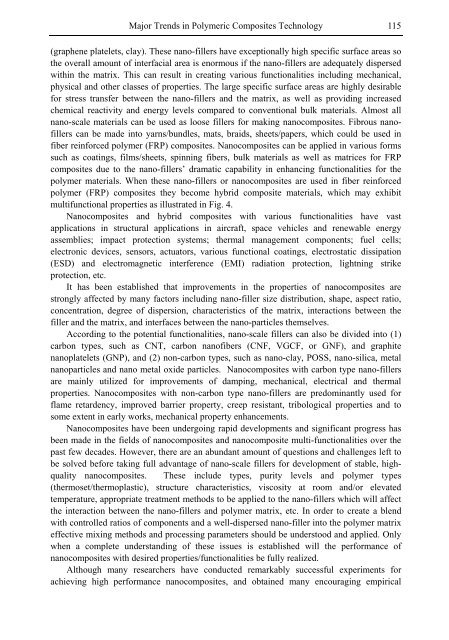Composite Materials Research Progress
Composite Materials Research Progress
Composite Materials Research Progress
You also want an ePaper? Increase the reach of your titles
YUMPU automatically turns print PDFs into web optimized ePapers that Google loves.
Major Trends in Polymeric <strong>Composite</strong>s Technology 115<br />
(graphene platelets, clay). These nano-fillers have exceptionally high specific surface areas so<br />
the overall amount of interfacial area is enormous if the nano-fillers are adequately dispersed<br />
within the matrix. This can result in creating various functionalities including mechanical,<br />
physical and other classes of properties. The large specific surface areas are highly desirable<br />
for stress transfer between the nano-fillers and the matrix, as well as providing increased<br />
chemical reactivity and energy levels compared to conventional bulk materials. Almost all<br />
nano-scale materials can be used as loose fillers for making nanocomposites. Fibrous nanofillers<br />
can be made into yarns/bundles, mats, braids, sheets/papers, which could be used in<br />
fiber reinforced polymer (FRP) composites. Nanocomposites can be applied in various forms<br />
such as coatings, films/sheets, spinning fibers, bulk materials as well as matrices for FRP<br />
composites due to the nano-fillers’ dramatic capability in enhancing functionalities for the<br />
polymer materials. When these nano-fillers or nanocomposites are used in fiber reinforced<br />
polymer (FRP) composites they become hybrid composite materials, which may exhibit<br />
multifunctional properties as illustrated in Fig. 4.<br />
Nanocomposites and hybrid composites with various functionalities have vast<br />
applications in structural applications in aircraft, space vehicles and renewable energy<br />
assemblies; impact protection systems; thermal management components; fuel cells;<br />
electronic devices, sensors, actuators, various functional coatings, electrostatic dissipation<br />
(ESD) and electromagnetic interference (EMI) radiation protection, lightning strike<br />
protection, etc.<br />
It has been established that improvements in the properties of nanocomposites are<br />
strongly affected by many factors including nano-filler size distribution, shape, aspect ratio,<br />
concentration, degree of dispersion, characteristics of the matrix, interactions between the<br />
filler and the matrix, and interfaces between the nano-particles themselves.<br />
According to the potential functionalities, nano-scale fillers can also be divided into (1)<br />
carbon types, such as CNT, carbon nanofibers (CNF, VGCF, or GNF), and graphite<br />
nanoplatelets (GNP), and (2) non-carbon types, such as nano-clay, POSS, nano-silica, metal<br />
nanoparticles and nano metal oxide particles. Nanocomposites with carbon type nano-fillers<br />
are mainly utilized for improvements of damping, mechanical, electrical and thermal<br />
properties. Nanocomposites with non-carbon type nano-fillers are predominantly used for<br />
flame retardency, improved barrier property, creep resistant, tribological properties and to<br />
some extent in early works, mechanical property enhancements.<br />
Nanocomposites have been undergoing rapid developments and significant progress has<br />
been made in the fields of nanocomposites and nanocomposite multi-functionalities over the<br />
past few decades. However, there are an abundant amount of questions and challenges left to<br />
be solved before taking full advantage of nano-scale fillers for development of stable, highquality<br />
nanocomposites. These include types, purity levels and polymer types<br />
(thermoset/thermoplastic), structure characteristics, viscosity at room and/or elevated<br />
temperature, appropriate treatment methods to be applied to the nano-fillers which will affect<br />
the interaction between the nano-fillers and polymer matrix, etc. In order to create a blend<br />
with controlled ratios of components and a well-dispersed nano-filler into the polymer matrix<br />
effective mixing methods and processing parameters should be understood and applied. Only<br />
when a complete understanding of these issues is established will the performance of<br />
nanocomposites with desired properties/functionalities be fully realized.<br />
Although many researchers have conducted remarkably successful experiments for<br />
achieving high performance nanocomposites, and obtained many encouraging empirical
















